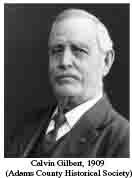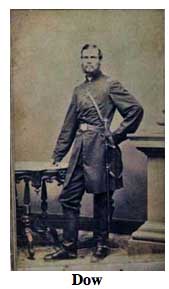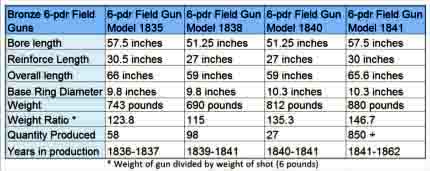
The 6-pounder was the smallest caliber cannon used in the War Between the States. Although of Mexican War vintage this smoothbore was still being used by many Confederate batteries especially at Antietam and Gettysburg. This gun is supposed to be a 12-pounder Napoleon. and both of these altered 6-pounders represent the artillery used by this battery while at this location on July 3, 1863. These modification were done in the 1890s by the Gettysburg National Battlefield Commission to overcome a shortage of guns for displays. The altered 6-pounders are easily identified as "false" Napoleons as the muzzle is flared and real Napoleons did not have a flare at the end, but the 6-pounder field guns do have a flare. The gun also stands out visually being 7 inches shorter than a real Napoleon. The modification included removing exterior features to present a smooth appearance. The process trimmed off the base ring and rounded the contours of the breech. However the neck of the knob retains a narrow fillet, unlike some “pho-poleon” conversions. The reinforce step just past the trunnions was smoothed down. The chase ring also disappeared under the cutting tools. The muzzle moldings remained. A sharp eye notes some slight differences between the moldings on the Revere gun and those of other Model 1841 guns. But this could of course be due to the alterations. SOURCE What sucks is the boring out of the gun obliterated most if not all of the registry information which once appeared on the muzzle.
Another interesting and distinction feature of this 6-pounder Revere is the reception mark over the trunnions, on top of and in front of the breech, on the back end of the gun. The mark of the Federal government are the initials of the United States. The U.S. is very ornate with texture using open block letters. The periods, somewhat elevated above the base line of text, look like 8 pointed stars with circled in the middle. The bronze gun has long ago lost its shine and now sports a green patina.
Another example of this exact type of gun @ Gettysburg (but without the alterations) is an Alger produced 6-pounder, registry #144 which can be found  HERE. Also, there are similar, altered guns to the south or left of this display which are identical but made at different foundries, one example (Ames Foundry) of which can be found
HERE. Also, there are similar, altered guns to the south or left of this display which are identical but made at different foundries, one example (Ames Foundry) of which can be found  HERE.
HERE.
 Through my investigations, I learned the man who made the tablets which accompany the cannons also had a hand in restoring these cannons as well. Gettysburg National Military Park has hundreds of these historic artillery pieces on its field of battle. Their carriages, sights, limbers and on rare occasion (should you find them), the caissons have all been restored. Much of the restorative work came from Major Calvin Gilbert who owned the foundry which bore his name in Gettysburg.
This man was responsible for creating all of the cast iron battery tablets. His work did not end there as his foundry created many of the carriages for the historic cannons at Gettysburg. Although almost all of the cannons are from the Civil War, their carriages, sights, limbers, wheels and caissons have been restored at his foundry in the early part of the 20th century. Gilbert was in his 70s when he did this work and completed work at other battlefields as well.
Through my investigations, I learned the man who made the tablets which accompany the cannons also had a hand in restoring these cannons as well. Gettysburg National Military Park has hundreds of these historic artillery pieces on its field of battle. Their carriages, sights, limbers and on rare occasion (should you find them), the caissons have all been restored. Much of the restorative work came from Major Calvin Gilbert who owned the foundry which bore his name in Gettysburg.
This man was responsible for creating all of the cast iron battery tablets. His work did not end there as his foundry created many of the carriages for the historic cannons at Gettysburg. Although almost all of the cannons are from the Civil War, their carriages, sights, limbers, wheels and caissons have been restored at his foundry in the early part of the 20th century. Gilbert was in his 70s when he did this work and completed work at other battlefields as well.
The two altered 6-pounders and the  6th Maine Battery Monument is located 400 feet to the north of
6th Maine Battery Monument is located 400 feet to the north of  Hancock Avenue (RD310), @ the intersection where Sedgwick Road changes its name to Hancock. United States Avenue also runs perpendicular at this intersection. This monument is accompanied by two altered six-pound bronze cannons. All of this is located on the left or west side of the road if traveling north along the avenue. It seems most of the monuments here have artillery pieces on both flanks like this monument. There is a long string of these in McGilvery’s Line set up on both sides of the road kind of terminating at the
Hancock Avenue (RD310), @ the intersection where Sedgwick Road changes its name to Hancock. United States Avenue also runs perpendicular at this intersection. This monument is accompanied by two altered six-pound bronze cannons. All of this is located on the left or west side of the road if traveling north along the avenue. It seems most of the monuments here have artillery pieces on both flanks like this monument. There is a long string of these in McGilvery’s Line set up on both sides of the road kind of terminating at the  Pennsylvania Monument (MN260); this is the second artillery display in that long line along Hancock Avenue. The cannons face due west, in the direction where the Union position was defending on July 3, 1863.
Pennsylvania Monument (MN260); this is the second artillery display in that long line along Hancock Avenue. The cannons face due west, in the direction where the Union position was defending on July 3, 1863.  This area is an absolute beehive of activity as this site represents the best of what Gettysburg has to offer, both historically and monumentally. Parking is plentiful and is available road-side at intermittently enlarged shoulder cut-outs, usually marked with white striping. Be sure to keep vehicles off the grass or you will be ticketed by park police. I visited the monument on Thursday, July 5, 2012 @ 5:31 PM, EDT & @ an altitude of 550 feet, ASL. I used a Canon PowerShot 14.1 Megapixel, SX210 IS digital camera for the photos.
This area is an absolute beehive of activity as this site represents the best of what Gettysburg has to offer, both historically and monumentally. Parking is plentiful and is available road-side at intermittently enlarged shoulder cut-outs, usually marked with white striping. Be sure to keep vehicles off the grass or you will be ticketed by park police. I visited the monument on Thursday, July 5, 2012 @ 5:31 PM, EDT & @ an altitude of 550 feet, ASL. I used a Canon PowerShot 14.1 Megapixel, SX210 IS digital camera for the photos.
p align="justify">Initially, I could not identify this gun. I learned from the HMDB site these two guns were originally 6-pounder altered to resemble the 12-pounder Napoleons. A thorough inspection of the trunnions yielded more information which eventually helped me cement a definite registry number. The proper left trunnion bears the date 1862 and the right proper trunnion reads Leeds & Co. New Orleans. Armed with this info, I went to the Robinson's Battery site. From there I discovered only one gun existed which was made at Leeds in 1861 and had been altered from a 6-pounder to a 12-pounder Napoleon. Curiously, the gun's registry is missing but the internal foundry number was available. I decided to use that number as my means for identification. My aforementioned SOURCE for all things weapons at Gettysburg provided me with the rest of the manufacturing information no longer readable on the battered muzzle, which is rather limited. I am presenting the data as the site presented it, not knowing the arrangement or order of the information as it appears on the muzzle.
FDY #6 ......Leeds ......1861 ......8?8
FDY #6 I believe means this was the 6th casting of this type of gun at the foundry. This is an internal control number specific to the foundry and required to be kept by the government who contracted these weapons as a means of quality control Leeds refers to the foundry,  Leeds Iron Foundry out of New Orleans, LA. This information is also stamped on the trunnion. The foundry is on the National Register of Historic Places. 1861 refers to the date of manufacture, twenty years after the model was first introduced in 1841. This number is also on the trunnion. 8?8 lbs refers to the weight of the firing tube. The last number is not readable. Each gun is usually very unique and has its own weight which distinguishes it from every other gun, like a fingerprint.
Leeds Iron Foundry out of New Orleans, LA. This information is also stamped on the trunnion. The foundry is on the National Register of Historic Places. 1861 refers to the date of manufacture, twenty years after the model was first introduced in 1841. This number is also on the trunnion. 8?8 lbs refers to the weight of the firing tube. The last number is not readable. Each gun is usually very unique and has its own weight which distinguishes it from every other gun, like a fingerprint.
About the Foundry
The Leeds Foundry produced arms for the Confederacy, manufactured two ships for the Confederate Navy, and continued as headquarters and producer of arms for anti-Federal forces after the war. Charles Leeds, the owner, was elected mayor in 1874. Charles J. Leeds, the thirty-third Mayor of New Orleans was born in Stonington, Connecticut in 1823. His parents were Jedediah Leeds and Mary Stanton who moved to New Orleans from Connecticut in the early part of the 19th century.
After Louisiana’s succession from the Union in January, 1861, the foundry manufactured arms for the Confederate Army. They had been contracted to construct two ironclad ships, the Louisiana and the Mississippi for the Confederate navy to repulse the inevitable invasion of New Orleans. The ships weren’t built quickly enough. When the federal navy approached, the Mississippi hadn’t been built and the Louisiana could only be towed down the Mississippi River and used as a floating battery. New Orleans was seized in April, 1862.
During Reconstruction, the Leeds Foundry was headquarters to Company D of the White League, a paramilitary group of white supremacists. The foundry fabricated artillery for the White League, including a canon. In 1874, the integrated Metropolitan Police of New Orleans attempted to intercept a shipment of arms to the White League. A battle erupted on the levee, dubbed the ‘Battle of Liberty Place.’ The League routed the police, whom they outnumbered two-to-one. The White League then occupied the State House and City Hall for a three day overthrow of the Kellogg State Government, until withdrawing ahead of Federal reenforcements. This increased Charles Leeds’s popularity, and he was elected the 33rd mayor of New Orleans the same year.
SOURCE
About the Gun
The Model 1841 6-pounder gun was one of a “family of weapons” designed by the U.S. Army Ordnance Department in 1841 (companion pieces were the Model 1841 12-Pdr., 24-Pdr. and 32-Pdr field Howitzers; the Model 1841 12-Pdr Gun and the 12-Pdr Mountain Howitzer). The effectiveness of the 1841 series was proven in the Mexican War, during which U.S. Ordnance gained an outstanding reputation for maneuverability and reliability. Most 1841 6-pounders were cast in bronze but in August and September 1841. at West Point Foundry, Captain William Maynadier inspected two cast iron 6-Pdr guns identified in the record as Model of 1841. Of essentially the same length and weight as those of bronze for the same model year, their base rings were 0.7 inches larger, or eleven inches in diameter, further supporting the tradition of broader taper for cast iron than for bronze weapons. The 6-Pdr was common to both armies in the early war years. The piece gradually fell into disfavor at the introduction of the Model 1857 Napoleon because of the bigger bore and hitting power. However, in the western theater the 6-Pdr soldiered on until the end of the war.
SOURCE.

About the Battery
The 6th Maine Artillery, Battery F was also known as Dow’s Battery (This is also written on the front of the monument). During the battle of Gettysburg, the unit served as a member of Taft’s Brigade in the Artillery Reserve, Army of the Potomac. The 6th was commanded by Lieutenant Edwin B. Dow (1835-1917), a clerk from Portland. Dow was wounded at Cold Harbor. Under his command were 103 men and 4 Napoleon cannons and among the men, 13 were wounded.
Born in Canada young Edwin Dow
was a 26 year old Portland, Maine
resident when on February 6, 1862
he was commissioned 2nd Lt. in
Freeman McGilvery’s 6th Maine
Battery. He would rise to the rank
of Captain and at Gettysburg his
name would be etched in stone as
commander of Dow’s 6th Maine
Battery. SOURCE
From the Historical Marker Database, Craig Swan: Dow's Battery was Battery F of the 6th Maine Light Artillery. It was commanded by Lieutenant Edwin B. Dow and was part of the 4th Volunteer Brigade, Artillery Reserve. Dow was attached to McGilvery's 1st Volunteer Brigade during most of the battle. Thrown into action on July 2 as the Federal Third Corps withdrew, the battery fought east of the Trostle Farm. Later it relocated on Cemetery Ridge, where it participated in the actions of July 3. The battery brought four 12-pounder Napoleon guns into the battle, and lost none. Eight men of the battery were wounded, and five horses were lost. SOURCE
The monument marks the positions of this Battery on July 3, 1863. The inscription reads:

(Front):Dow's
6th Maine
Battery
(Left):McGilvery's Brigade.
Reserve Artillery.
(Right):Campaigns A.P.
1862.-1865.
This area is crazy-stupid with all types of cannons and guns and monuments as far as the eyes (or binoculars) can see, a veritable outside museum. I would suggest allowing up to an hour and a half to walk around Hancock Avenue to fully inspect all the tablets, monuments and weapons in this area.